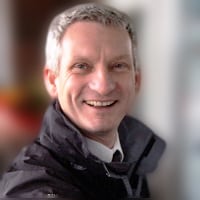We’ve been incredibly busy this summer, but Bryan found time to accept an invitation to visit to the Safeguards Europe UK Headquarters in Horsham. For those who don’t know, Safeguard are our principle supplier of Damp-proofing, timber treatment, concrete waterproofing and basement waterproofing products.
Unlike some remedial suppliers, Safeguard don’t just distribute products made by others – they actually research, test and manufacture on site, so Bryan was dying to get behind the scenes and see how.
Inside this building are racks and shelves of Vandex waterproofing products, Dry Zone dpc cream, soluguard micro-emulsions and borate based preservatives. They’re impressive, but not surprising. The real shock came when safeguard’s chief boffin Dr Eric Rirsch, revealed the testing bays and laboratory.
First Surprise: Rows and rows of brick walls, built on-site, in trays of salty water!
Second shock: Brick piers; built on paving flags, some rendered, some naked brick. All have a central column of sharp sand, soaked with a standard saline mix. Eric enthused about the work going on here, and couldn’t help taking notes and checking results as he went around the place.
The piers and walls are not just for show. Eric has constructed them from a diverse selection of mortar mixes, designed to emulate ‘traditional’ and ‘old’ house walls.
Lime based mortars are used. The saline solution matches an accepted national control mix, which allows measurements of salt build-up, and damp absorption in the structures, to be recorded. Water rises up through the minute capillaries in brick and bed-joint material, just like it does in houses. Once the rising damp is active and demonstrably happening, Eric and his team start to try and stop it.
The team are dedicated and relentless. they check capillary and hygroscopic water content. Chemical analysis, bespoke high end software and electron microscopes are is used to check the effectiveness of Safeguard’s rising damp treatments. Even time-lapse photography is employed to monitor visual changes, because as Eric says “Customers are not that interested in the science, they just want a dry wall, free from stains”. Quite so, It’s no use telling a housewife in Leeds that her damp course is working; according to a moisture meter, if her wall is visible stained.
Moving on, to the Lab. This is where all the testing needed to design and produce effective remedial treatments is done.
All labs have microscopes, scales, ovens, enclosed reactors, and rigs of the type installed here. The surprise is the scale of it. Hundreds of samples are tested; water repellents, timber treatments, waterproofing slurries, an endless list.
Bryan’s guide explained why so many are needed; it’s not only a case of getting something to perform on site. The products must be stable in storage and transit – safe to use – not too complicated to manufacture – ingredients must be readily available and safe – and then…it has to work…… and be available at a sensible price.
Hudson is immensely proud of the Safeguard Europe team’s efforts in Horsham. He spent two days going over all his products and demonstrating how Safeguard are striving to improve all of the time.
Presentations ranged from DryZone damp-proofing cream to StormDry water repellent cream, flood remediation and protection, Oldroyd type C waterproofing membranes and proven Vandex cementitious Type A waterproofing products.
Safeguard people love what they do, that’s what really binds our business relationship. Their passion for preservation stands out a mile.
Bryan came back bursting with new ideas and applications for Safeguard’s latest range. We’ve already being able to help customers with solutions for: penetrating damp; problems with damp floor/wall junctions; even waterproofing a 1500m2 concrete floor slab on a prestigious new care home.
This trip demonstrates how even the most experienced specialists in the preservation industry need to go out and look for improvements; they are always there.
Our thanks go to Safeguard Europe, in particular Hudson Lambert, Eric Rirsch and Robert Deary.
